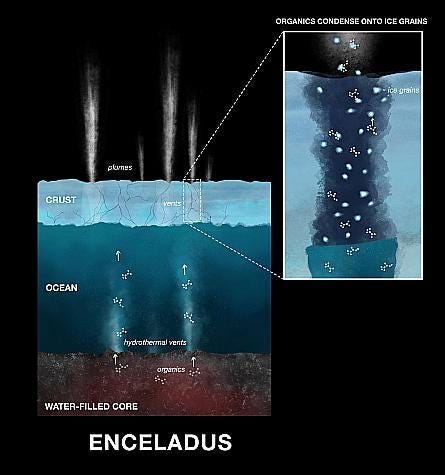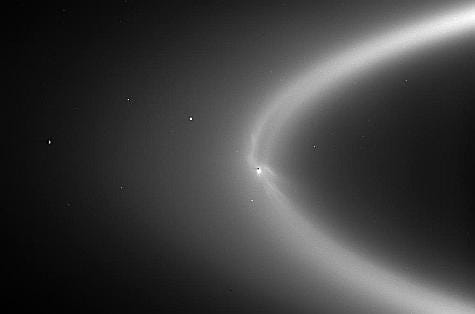Discovering Organic Compounds Erupting from Enceladus' Geysers
Written on
Chapter 1: Enceladus and Its Mysterious Geysers
Recent studies have unveiled intriguing findings regarding the icy moon Enceladus, which orbits Saturn. This moon is renowned for its active geysers that regularly erupt with plumes of water and rocky substances. While much of the water released settles on the surface, some of it escapes into the vastness of space. Notably, a recent study has identified organic compounds essential for amino acid formation among the materials expelled from these geysers.
Given the right conditions and energy, these organic compounds could potentially synthesize amino acids. On Earth, hydrothermal vents on the ocean floor provide the necessary energy for this process. Scientists propose that the geysers on Enceladus could similarly supply the energy required for amino acid formation in its subsurface ocean.
“If the conditions align, the molecules emerging from Enceladus’ depths could be undergoing reactions akin to those we observe on Earth. While we have yet to determine whether amino acids are crucial for extraterrestrial life, discovering the molecules that lead to their formation is a significant advancement in our search,” explained Nozair Khawaja from the Free University of Berlin.

This artist's illustration depicts geysers erupting from Enceladus' southern pole, showcasing the dynamic nature of this moon. Image credit: NASA/JPL-Caltech.
The materials observed in the Cassini spacecraft's data comprise nitrogen- and oxygen-rich compounds condensed into ice grains. The Cosmic Dust Analyzer (CDA) was responsible for detecting these ice grains, which were emitted from Enceladus into Saturn’s E ring.
Researchers elaborated, “Enceladus is expelling a plume of gas and ice grains from its south pole, directly linked to a global subsurface ocean. This material travels through fissures in the icy surface and is ejected into space. It is believed that this subsurface ocean interacts with the rocky core, sustaining hydrothermal activity.”
In early 2017, the Cassini spacecraft conducted close flybys of Enceladus, coming within 500 kilometers (310 miles) of its surface. In contrast, Voyager 1's closest approach in 1981 was nearly 90,000 kilometers (around 56,000 miles) away.
Chapter 2: The Unique Characteristics of Enceladus
Enceladus, measuring approximately 500 kilometers (310 miles) across, is comparable in size to the state of Arizona. It stands out as one of the few moons in our Solar System with a detectable atmosphere, albeit a very thin one. Due to its mass, which is 680 times less than that of Earth's Moon, Enceladus struggles to retain a dense atmosphere, allowing water vapor to escape into space.
This tenuous atmosphere was identified through slight fluctuations in Saturn's magnetic field, caused by electrically charged particles surrounding Enceladus. In 2005, observations of water in the moon's thin atmosphere provided the first indication that geysers on the surface are continually replenishing water.

As Enceladus rotates approximately every 33 hours, a steady snowfall of ice and snow occurs, making it one of the brightest objects in the Solar System. It is believed that a vast ocean of salty water lies beneath its icy crust, where organic materials mix with water before rising to the surface, eventually freezing into ice grains located within the moon's fractures.
Cassini’s findings also revealed that one of Saturn's major rings, the E ring, is consistently replenished with material from Enceladus' geysers.

“The material is propelled at speeds of about 800 miles per hour (400 meters per second), creating a plume that extends several hundred miles into space. Some of this material falls back onto Enceladus, while a portion escapes, contributing to the formation of Saturn’s expansive E ring,” NASA explains.
Discovered in 1966, this ring is less defined than Saturn's other rings, resembling a massive doughnut encircling the planet.
The Cassini mission concluded in September 2017, when the spacecraft was deliberately directed to plunge into Saturn’s thick atmosphere, preventing it from colliding with any of the numerous moons in the future.

In Greek mythology, Enceladus was a giant who battled Athena during the Gigantomachy, a legendary war between gods and giants. This tale has inspired many artworks throughout history.
Within our solar system, several celestial bodies may harbor conditions suitable for simple life forms, similar to those that dominated Earth for much of its history. The discovery of organic materials, coupled with the potential for a complex layer of organic substances within Enceladus' ocean, makes this moon an exciting target in the ongoing search for extraterrestrial life.
Did you enjoy this article? Subscribe to The Cosmic Companion Newsletter!